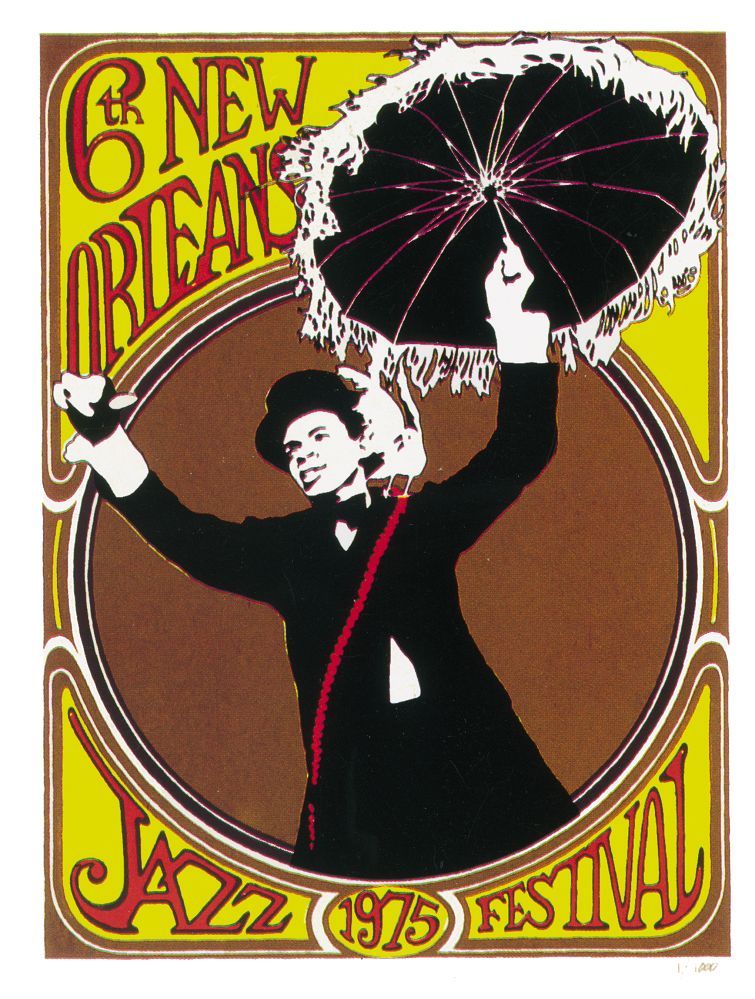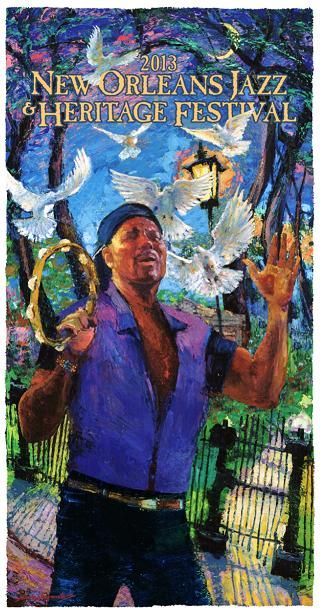Jazz Fest poster has Freeman School roots
In the 38 years since its debut, the official New Orleans Jazz & Heritage Festival poster has become as much a part of the annual celebration as Irma Thomas, Crawfish Monica and Rosemint Tea, but few fans are probably aware that the highly collectible posters—which fetch hundreds of dollars on eBay—got their start as a class project at the A. B. Freeman School of Business.

In 1975, Bud Brimberg (L ’75) was a third-year law student casting about for a class to take just for the fun of it. Unable to find anything to his liking at the law school, he wandered over to the Freeman School and signed up for the only course that didn’t require any business school prerequisites, a recently introduced class called Entrepreneurship and the New Business Enterprise.
Developed by marketing professor Bill Bennett and based on a class he’d taken at Harvard Business School, the course consisted primarily of case studies, but Bennett also required his students to complete a class project. Each student was asked to create a pro forma for a proposed business detailing the venture’s capital requirements and projected cash flows and income. Those numbers would then have to be programmed in FORTRAN and run on the university’s mainframe computer.
That’s a lot of work for just a simulation, Brimberg thought. One day after class, he approached Bennett and asked if instead of writing a pro forma he could actually start a business.
“He looked at me and he said, ‘That’s highly unorthodox,’” Brimberg recalls with a laugh. “I looked at him and said, ‘For God’s sake, it’s entrepreneurship!’ And he said, ‘Well, go ahead.’ And that was it.”
From the beginning, Brimberg focused his entrepreneurial attention on Jazz Fest, which was then in its sixth year. His original plan was to make a live recording in the Gospel Tent and release it as an album, but when that concept didn’t pan out, he went to his friend Quint Davis, producer of the Fest, and pitched his second idea: a high-quality commemorative print in the style of classic French poster art. Davis was skeptical.
“We’ve already got a poster,” he said, pointing to the cardboard placards volunteers would staple to telephone poles around town to promote the Fest.
Brimberg explained he was proposing something very different, a numbered, limited-edition print silk-screened onto museum-quality paper. Davis still wasn’t convinced.
“Okay, I’ll tell you what,” Brimberg finally said. “Maybe you’re right, but I think I can come up with some program that will work and I’ll pay you off the top a percentage of gross. No risk. I’ll underwrite the whole thing. And if I sell one poster, you’ll make money.”

It was an offer Davis couldn’t refuse. Brimberg commissioned two Tulane architecture students to create a design featuring an umbrella-waving parade grand marshal with lettering in the classic art nouveau style. The hand-pulled edition of 1,000 posters sold for $3.95 each at the Fest, and Brimberg spent much of his time explaining to customers why that was such a good deal.
When the dust settled, Brimberg walked away from the Fest with less than $500 in profits (and an A in the class). It may not have been much, but it was enough to launch Brimberg on what’s become an almost 40-year career as a businessman and entrepreneur.
He went on to found ProCreations Publishing Co. and Art4Now, which together have produced the Jazz Fest poster every year with the exception of a three-year stretch in the early ’90s. In 1994, Brimberg began producing the Congo Square poster as well, and in 1998 he debuted an expanded line of Jazz Fest apparel — BayouWear — based on the popular “HowAhYa” Hawaiian shirt he’d introduced in 1981. He also started a number of other businesses along the way, most notably Plan-A-Flex, a manufacturer of architectural design and planning kits. Brimberg sold that company to Stanley Works in 1986.
Looking back on his career, Brimberg credits the Freeman School and that first entrepreneurship class with giving him the tools he needed to be successful.
“If you try to understand what makes a frog jump by cutting it open, which is what most academics do, you really don’t know what makes a frog jump,” Brimberg says. “But if you sit there and observe the frog from every angle, you may not understand the molecular level, but you’ll understand what makes the frog jump. I think what [the entrepreneurship class] did was make me understand how the frog jumped. It showed me all the moving parts you would need to start a business and how everything locked together. So, yes, it was pretty useful.”